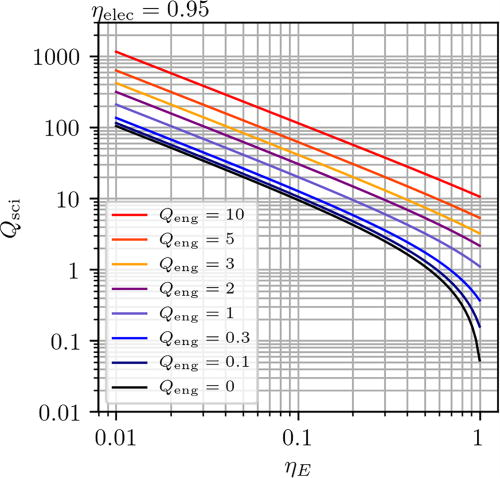How to make fusion electricity without ignition
Dr. David Kirtley, CEO

You’ve probably heard of fusion success being measured by “ignition.” Makes sense – the most talked about fusion results in recent years came from the National Ignition Facility (NIF).
From the earliest introduction of plasma physics in college, ignition is taught as the ultimate goal. It’s baked into how we think about fusion energy: the idea that success means creating a plasma so hot and so well-confined that it heats itself with fusion reactions, needs no help to keep going, and produces so much energy that the engineering of how to make electricity or how efficiently you heat the fuel is treated as an afterthought.
At Helion, our goal is not to just do a lot of fusion or make energy, but to make a product the world needs – clean, baseload electricity. And to do this, ignition isn’t required!
What is ignition?
You can think about increasing fusion output as a series of thresholds. Key to that is the triple product: the product of the fuel density, temperature, and time. This tells you how likely fusion reactions are to occur.
As you increase triple product, you reach the first threshold: thermonuclear fusion. This is where you get significant fusion reactions – enough that you can measure and quantify that fusion is happening in a way that can scale to generators. Helion’s founders reached this threshold in 2011 with the Inductive Plasmoid Accelerator (IPA).1
The second threshold is getting more heat energy out of the reaction process than you put into it. And if you increase the triple product enough, you reach the point where sufficient fusion is happening so that the energy from fusion products, like alpha particles, heats the plasma faster than the plasma can cool down. This is the threshold for self-heating.
Go even further and you reach ignition, where now the plasma is heating itself enough to overcome all losses, no external heating is needed, and the amount of fusion energy dramatically increases.
We call this condition a burning plasma – a remarkable physics milestone, but removed from the goal of electricity production, because you could make electricity at any one of these steps.
Non-ignition fusion
Not all fusion is equal, and not all fusion systems require ignition, as illustrated in a figure below from a Physics of Plasmas journal article by Sam Wurzel and Scott Hsu.2 If 95% of the input energy after the pulse is recovered (ηelec) and the electricity to heating efficiency (ηE) is high, then net electricity production (Qeng) is possible even when the scientific energy gain (Qsci) is below 1.
Wurzel and Hsu define Qsci as the ratio of power released in fusion reactions to applied external heating power, encapsulating the physics of plasma heating, thermal and radiative losses, and fusion energy production and assumes all heating energy is lost in the process. Qeng is defined as the ratio of electrical power (delivered to the grid) to the input (recirculating) electrical power used to heat, sustain, control, and/or assemble the fusion plasma. As an aside, we do what we can to avoid talking about Q values, as terminology and definitions begin to become a big loop, which is why our main goal is simply electricity production.
With high-efficiency heating and recovery and reuse of electricity put into the system, the burden on fusion gain drops significantly. You no longer need to cross the ignition threshold, or even reach scientific breakeven, to make power. That is the foundation of Helion’s approach. Our fusion system is designed to operate with high efficiencies in this range, enabling us to produce electricity at lower fusion yields and without relying on ignition.
Three factors that eliminate the need for ignition
We have built Helion’s fusion system to be highly efficient. Because of that, we do not need to reach ignition to generate electricity. Here’s how:
-
Direct energy conversion
Helion recovers fusion energy magnetically, not thermally.
Instead of turning fusion heat into steam, then into mechanical motion, and finally into electricity, our system skips all those steps. When fusion occurs in our field reversed configuration (FRC) plasmas, the hot plasma expands and pushes back on the magnetic field around it. That push induces current in the coils, like regenerative braking in an electric vehicle, and feeds electricity directly back into the system. Even more than that, we recover as much of the input electricity as possible, so that fusion only has to make up the little amount we cannot recover.
This direct energy conversion means we do not need turbines or cooling towers. It reduces the size, complexity, and cost of the system, and it allows us to generate electricity at much lower fusion yields.
-
High beta
Beta is the ratio of plasma pressure to magnetic pressure. Most fusion systems operate at a beta of 10% or less. Helion’s FRCs operate at high beta, approaching a ratio of 1, or 100%.3
That means we can confine high-pressure plasma using relatively modest magnetic fields. This is incredibly efficient: for every unit of energy applied by the magnetic field, we get nearly one unit of energy in the plasma itself.
High beta gives us more output for less input. And that further reduces the need for high-yield fusion and unlocks advanced fusion fuels like D-He-3.
-
Pulsed operation
Unlike steady-state fusion machines that try to maintain plasma indefinitely, Helion’s system operates in short pulses, each lasting less than a millisecond.4
These short pulses avoid many of the confinement and stability problems faced by continuous systems. They also make the entire fusion process behave more like a heat engine, where plasma is compressed, reacts, expands, and pushes back on the magnetic fields to generate electricity.
Because each pulse is quick and self-contained, we do not need the plasma to self-sustain through ignition. We just need the fusion energy in each pulse to exceed the system’s internal losses. That is a much more achievable and controllable target.
Electricity production is the goal
At Helion, we are not building a machine to do the most fusion, we are building a machine to generate the most electricity.
We optimize for the minimum amount of fusion needed to make power, not for reaching the most extreme physics milestones. This gives us a path to commercial fusion that avoids the challenging physics of ignition and sustaining a burning plasma.
We have chosen to accept engineering challenges instead. Things like fast pulsed switching, power electronics, and magnetic control are difficult, but solvable.
That tradeoff, less physics risk and more engineering effort, is what allows us to move faster. We believe it is also what will get us to the real goal of fusion – getting electricity to the grid.
